Exotic plants are plants that have been introduced into a region or ecosystem where they are foreign or non-native. An exotic flower or plant is a flower that grows in a specific region or ecosystem. These are very hard to find and are not available in the market. Exotic flowers are also called introduced flowers. Because of their unusual beauty, these flowers can be invasive and even dominate the area.
How to start exotic flower farming in India
Conditions required for exotic flower farming
Many people also love exotic flowers because of their wonderful adaptability. One of the most popular features of these flowers is their bright, vivid, and cheerful colors. Apart from their extraordinary beauty, these flowers have a lot of importance. Each of them represents a specific and meaningful message. If you have the time to arrange flowers and plants yourself, you should understand that exotic flowers require much more care than ordinary flowers.
Tropical or exotic flowers are grown under conditions unlikely to be enjoyed when you enter your home. Therefore, you are responsible for ensuring they receive the special treatment they need and not experience less than favorable conditions. They also require the grower to research the plant to ensure it is properly fed and cared for.
While aliens are unique natives of certain land, they adapt and thrive when introduced to an alien ecosystem. These exotic flowers are in high demand for their adaptability and are widely used in event decorations and beautiful floral arrangements.
Choose a location for growing exotic flowers
Before you start planting flowers, plan your drainage system. Drainage is extremely important to successful flower gardening. Flowers and other plants can become waterlogged without proper drainage or suffer from root rot. Root rot will kill a plant fairly quickly and can spread to other plants. Avoiding excessive waterlogging is essential for a successful garden. Try to plant your flower garden in a location that provides the best drainage to avoid this happening to your garden.
Plant flowers that require a lot of water in areas with high humidity. They will stay well hydrated and help prevent root rot. You can also try a flower garden if drainage is a major problem. For tropical plant care, use a potting mix of peat moss, perlite, and vermiculite. Provide 12-14 hours of bright indirect light.
Water tropical plants once a week and within a temperature range of 18 -24°C. Provide 60% or higher humidity. Fertilize twice weekly in the spring and summer using a liquid fertilizer. Tropical plants need a well-draining potting mix containing ingredients such as peat moss, perlite, and vermiculite. Water tropical plants once a week when the top 2 inches of soil is dry and keep the soil slightly moist but never soggy. Water needs to be able to drain.
Shelter your exotic flower plants
Firstly, ensure that the area you choose for your flower garden will receive adequate sunlight. Most flowers need plenty of natural light, so visit the area you’re considering for a few days to determine if it gets enough sun throughout the day. If so, it would be a prime location for flowering. If your space has limited sunlight, you must look for flowers that require partial sun.
Tropical plants grow in layered, tropical forests. Natural tropical environments usually have soft, delicate leaves and canopy surfaces to protect plants from strong winds. You will want to mimic a temperate forest with a canopy to create a shelter that protects your plants’ delicate, beautiful green leaves. If you can’t keep your tropical plants in a house or building that offers protection, consider building a tall fence or hedge, which can act as a wind barrier.
The shelter will help protect your tropical plants from dry, intense heat, which can cause tropical plants to wilt. Use a heavy mulch to retain moisture in areas prone to extremely hot temperatures, dry air, or drought. A heavy mulch can keep the roots of your plants warm during low temperatures, frost, and snow.
Tips for exotic flower farming
- Exotic flowers are those native to tropical climates. These flowers sometimes require more extensive care than less exotic flower species, but their bright colors and striking appearance make them worth it. To keep your exotic flower healthy, it’s important to cut the stems and put them in freshwater as soon as possible. To help your indoor flowers thrive, monitor room temperature and resist overwatering.
- Tropical flowers do not do well without water. So when you get your hands on your beautiful bouquet of exotic flowers, you should take them out of their package and run them into some fresh water from your sink. And never, we repeat, never refrigerate tropical flowers. It’s a fast lane to floral heaven, to put it mildly.
- Once you’ve unrolled your bow, it’s time to cut off the excess foliage on each stem. Firstly, this means removing any discolored or dead petals or leaves. And second, it means removing any vegetation that remains below the water line of your vase, as the leaves can introduce bacteria into your water.
- When arranging flowers, you’ll want to cut 1/2 inch off the stems using a sharp knife or garden shears. But make sure to cut the stem at a 45-degree angle while keeping the stem under room-temperature water. They will thank you.
- Tropical flowers like hot, humid, and sunny areas, so avoid keeping them in a room with low light or cool drafts. Also, never place cut flowers in direct sunlight.
- Reposition the flowers every 1-2 days. To extend the vase life of your tropical flowers, you should change their water, trim their stems, and remove excess or dead plants at least every other day. Exotic flowers absorb water directly through their flowers, so it’s also a good idea to wash them with water every day.
- Tropical flowers do not do well without water for long periods. When you get home, pick your flowers and prepare them for the vase. The sooner you put them in freshwater, the longer they will live for you to enjoy. To keep exotic flowers looking their best, cut each stem back a little every few days. Make sure your knife or scissors are sharp enough to cut cleanly.
- These exotic flowers are perhaps the most unique and attractive in the entire flower world. Some exotic flowers have vines that prefer to grow upwards and wrap around things. Research your plant to see if it will benefit from a trellis nearby. For example, a healthy flower vine will attach itself to a nearby trellis and cover it with foliage. You can purchase wooden or metal trellis at your local gardening store.
- If your exotic flowers are potted, bring them into your garage or atrium to escape the colder months. Other tropical plants, such as hibiscus, can usually survive outside if the temperature does not drop below freezing. If it does freeze, place a blanket or bucket over your plants to minimize frost damage. You can also let your plants die seasonally and only replant in the spring.
List of Exotic flowers in India
Orchids
The orchid is one of the most famous exotic flowers in the world. These plants thrive in bright light but not in the late afternoon sun. They also need more moisture and airflow around the roots. They require alternating drying with heavy water. As a general rule, orchids should be watered once a week. Orchids must be given as much light as they can tolerate. Give your orchid bright, indirect light, preferably in an east- or south-facing window.
In case you missed it: How to Start Exotic Fruit Farming in India: A Production and Growing Guide for Beginners
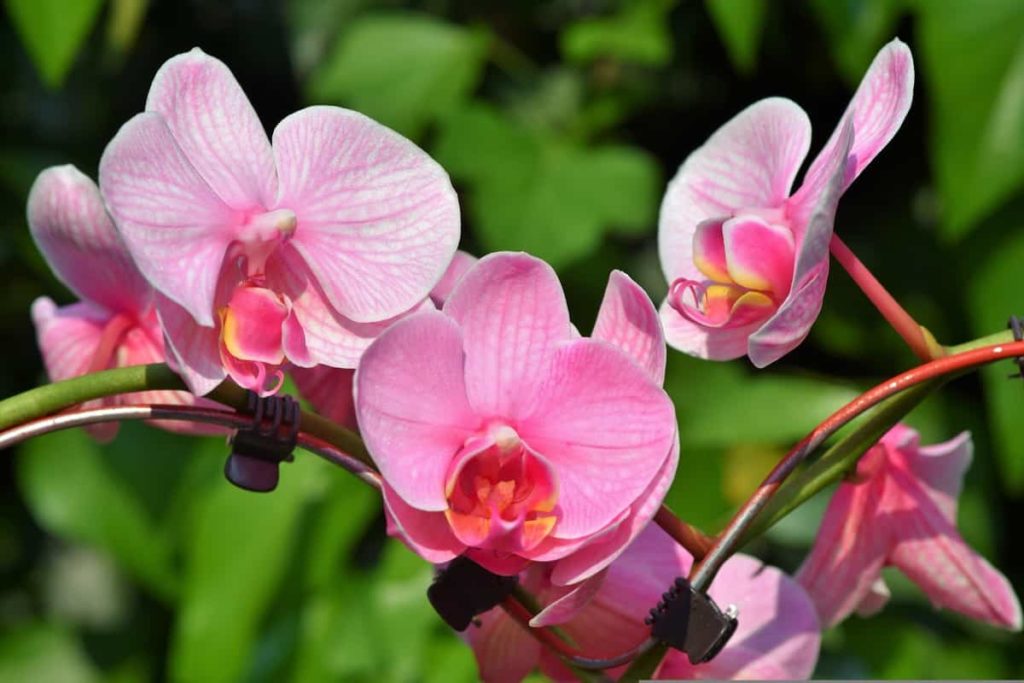
Orchids are plants belonging to the Orchidaceae family, a diverse and extensive group of flowering plants that are often colorful and fragrant. Orchids are said to be the most exotic of all flowers. Their delicate beauty has made them a favorite corsage flower. This plant family comes in a stunning array of shapes, sizes, and colors. Orchids grow wild in all but the coldest climates around the world. About 25,000 to 30,000 species are to appreciate, but one of the most popular types is the cascade orchid. Orchids bloom year-round and are available in a variety of colors.
Cigar Flowers
Botanically known as Cuphea ignea, cigar plant flowers bloom in full sun to partial shade. A small cigar plant shrub usually does not exceed 24 inches (61 cm) in height, although some cigar plant information suggests it can reach a height and spread of up to 3 feet (1 meter). It usually lives in a neat, mounded clump. The attractive plant also attracts hummingbirds to the garden.
Caring for cigar plants involves growing them in the right soil and watering them well. You will be blessed with abundant flowers from a properly located plant. Growing cigar plants requires light to average soil that drains well. Although somewhat drought resistant, the cigar plant does best when watered regularly. The plant is attractive, ornamental, and useful as a bright front border shrub or bedding plant.
Its clean and compact form also makes it an excellent choice for growing in containers that will add a splash of color to patios, balconies, or terraces. For optimal flowering potential and growth, Mexican cigar plants prefer moist conditions and appreciate adequate watering. It is especially important when they are getting established and through their growing season.
Bromeliads
Bromeliads are easy to grow as houseplants and bring interesting texture and color to the indoor garden. Bromeliad plants are easy to care for and require no special tools or fertilizers. Feed the plants with a half-strength fertilizer every month during the growing season. Indoor bromeliads thrive in fast-draining potting soil that is moist but well-draining.
In case you missed it: Exotic Herbs Farming in India: A Growing and Production Guide for Beginners
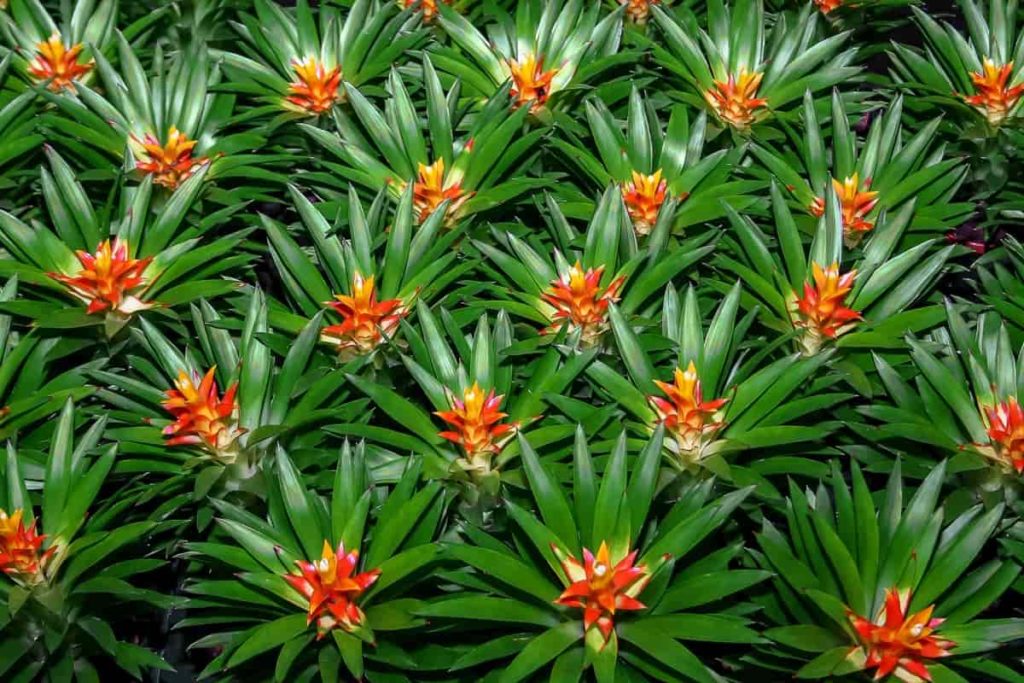
A mixture of two-thirds peat-based soil and one-third sand is often ideal. You can also use orchid mix, charcoal, or soilless potting mix. Bromeliads are not heavy feeders. During the growing season, use liquid fertilizer at half strength. Avoid feeding mature plants in winter or when the plant is beginning to flower.
Anthurium
These flower plants can tolerate all levels of indirect light, but Anthuriums grown in low light will have fewer flowers and grow more slowly. Anthurium flowers bloom in red, pink, purple, orange, white, and black colors. Bright light and fertilizer are the keys to flowering. Anthurium plants thrive in bright, indirect light and do not like direct sunlight, except during the winter or in plants that are carefully acclimatized.
These flowers may look like something from an alien planet, but they are native to the rainforests of Colombia. Their waxy appearance and bold spadix bring a touch of the exotic to any flower bouquet. Anthuriums have several fun names, including Painter’s Palette, Painted Tongue, Boy Flower, and our favorite, Flamingo Flower.
In case you missed it: Anthurium Cultivation in Greenhouse, Project Report
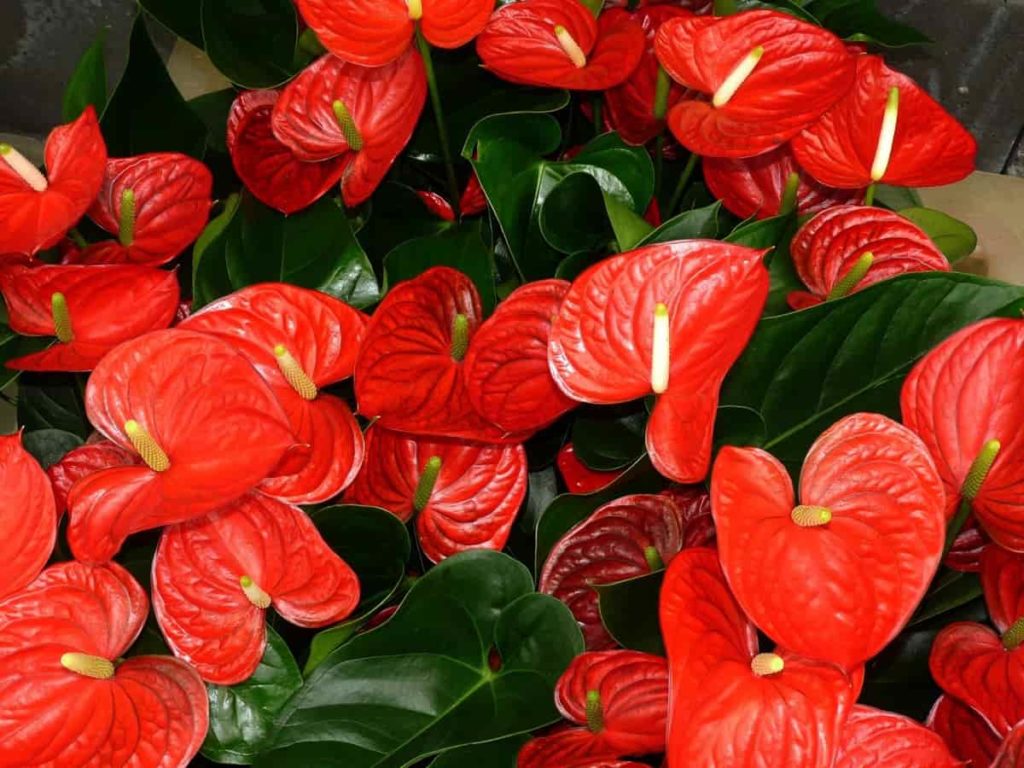
They are also available in many bright and beautiful colors, from white and orange to purple and green. Despite their exotic appeal, Anthuriums are relatively easy to care for and have the longest vase life of all cut flowers. If you want to fill a vase full of these beauties, remember to keep them away from draughts or direct heat (a top care tip that applies to most exotic flowers).
Lily of the Valley
A flowering plant native to Europe, the flowering plant is often considered a symbol of the return of happiness. One of their best features is the amazing fragrance they produce, but if you’re looking for a plant that can offer a long-lasting soothing scent, keep in mind that these flowers can last only a week or less. The milky white bell-like flowers of the lily of the valley look mesmerizing. These attractive, fragrant flowers grow in clusters on leafless stalks against bright green foliage.
African violets
African violets are native to the coastal forests of East Africa but have become popular indoor plants in the United States. The flowers are deep purple, and the plant can bloom in the right light year-round. Most plants are sold when they flower.
In case you missed it: Best Place to Buy Plant Seeds Online in India: For Vegetables, Flowers, Fruits, Herbs, and Hybrid Seeds
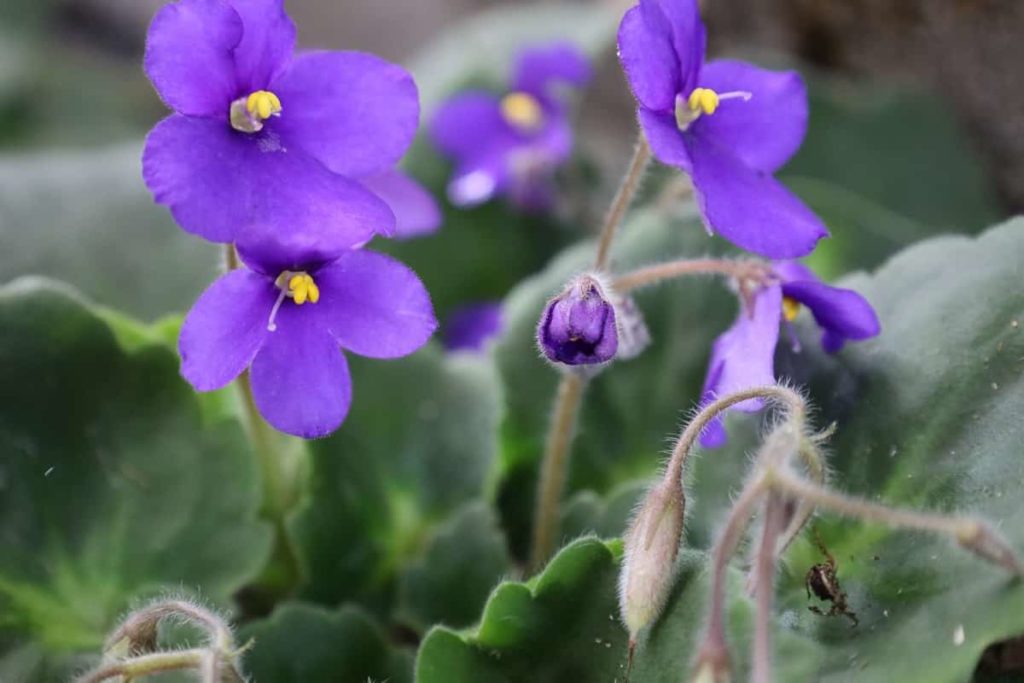
African violets do best and bloom best in bright, indirect light plant African violets in small pots and mix them in fresh soil every few years. A little potting encourages African violets to bloom more, so don’t be too quick to give them too much space. African violets will thrive in bright, warm, and humid conditions. Avoid water touching their leaves, or it will cause brown spots.
Amaryllis
It is native to South Africa and one of the most beloved exotic flowers for cultivation. The magnificent flower demands minimal maintenance effort. You don’t need to water the plant or provide a special soil type. The plant’s adaptability is well expressed in its symbolic meaning and strength. Amaryllis is available in many colors.
Like red, orange, pink, purple, yellow, green, and even multicolored. Originally, this wonderful bloom was fragrance-free until the fragrant amaryllis was discovered and gained popularity. The amaryllis fragrance has hints of water lily and daffodil, a perfect sweet and fresh combination.
Calla Lily
It is a plant native to South Africa for its unusual fluted flowers and vibrant green leaves. This lily is popular in wedding bouquets but also looks stunning in a vase in your home. These exotic flowers are simply beautiful and relatively easy to care for. Along with its classic white flower, the Calla Lily also grows in shades of pink, purple, yellow, and black.
Crown Flower
The Crown flower is a poisonous plant and is the mother flower in India, offered to Lord Shiva for peace and prosperity. Crown flower does best in sunny locations but can tolerate some shade. Crown flower plants require abundant, bright, and direct light. Keep it less than a foot from a window to ensure it gets enough light to survive. Select a region to see how your area’s current weather affects your home placement.
Grow crown imperial in a bed that receives six to eight hours of full sunlight daily and provides excellent drainage. Apply about 1 inch of water weekly to moisten the top 6 inches of soil. Avoid standing water and wet soil. Space plants 9 to 12 inches apart to reduce mildew problems, rust, and leaf spots due to poor air circulation. Stop watering the plants after they die. Divide the bulbs every three to five years in autumn, when the plants have become crowded.
Mahua Flower
The Mahua tree is a tropical tree found mostly in the plains and forests of central India. Mahua is a medium-sized, slender tree growing to a height of 16-20 meters. Mahua is an economically multi-purpose tree. It grows well, with annual rainfall between 500 mm and 1500 mm. Mahua does best on deep loamy or sandy loam soils with good drainage and shallow stony, silty, and calcareous soils.
Bird of paradise
The bird of paradise or crane flower is native to South Africa but is naturalized in India and Bangladesh. One of the most dramatic flowers features pointed, multicolored petals in shades of yellow, blue, red, and green. Each petal individually forms the first step that gives it the appearance of a bird in flight.
In case you missed it: Bird of Paradise Flower Farming in India – A Full Guide
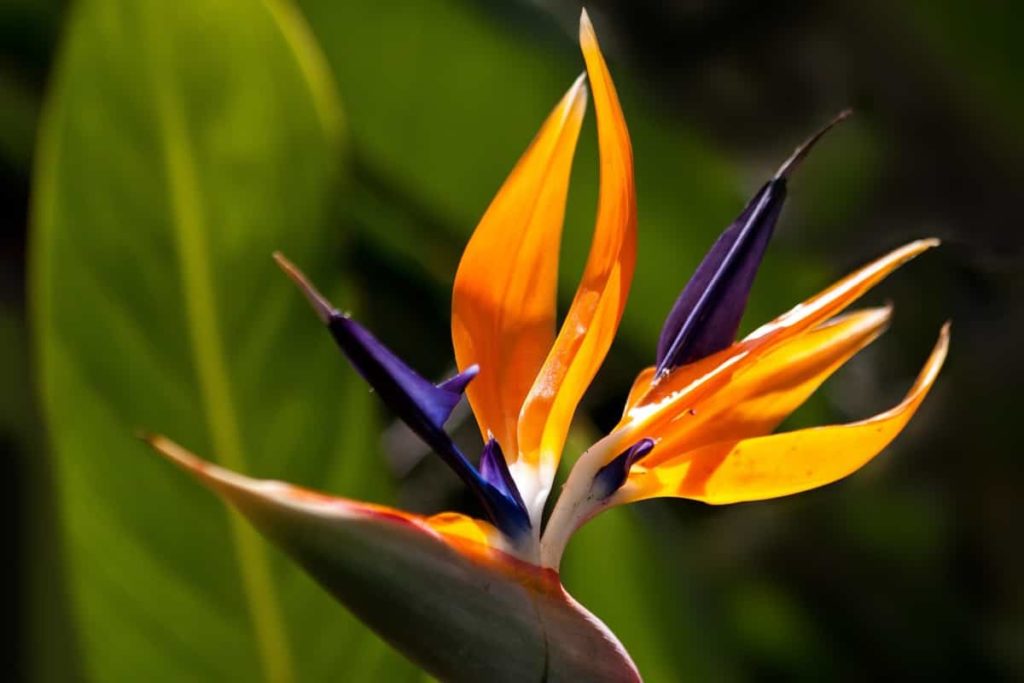
Yakla Snow Lotus
It is one of the most beautiful flowers. It is found only in the highest reaches of the Himalayan mountain range; this rare and magnificent flower is a thing of beauty that draws a dozen admiring glances. With black-centered petals that extend like purple hairs to act as temperature regulators, this rare and exotic flower is always a treat to cherish.
Peace Lily
One of the most amazing flowers, the peace lily is long-lasting and looks stunning with its colorful spathes. It is native to the tropical regions of America and Southeast Asia. Peace lilies, also known as closet plants, are popular for offices and homes. The Peace Lily is a genus of about 47 species of monocotyledonous flowering plants in the family Araceae, native to tropical regions of the Americas and Southeast Asia.
Peace lilies can survive in low to bright, indirect sunlight. They are the perfect plant to bring life to a dark room or corner. Prolonged exposure to bright direct sunlight can burn and scorch their leaves and wither their flowers. Peace lily plants have dark green leaves with white flowers. This white flower is a distinct bract of leaves that grows over the flowers.
Tulips
Tulips were first found in Turkey and Central Asia; today, most are originally grown in the Netherlands before being exported elsewhere. These are extremely popular spring flowers and over 3,000 registered varieties. Tulips are a great choice because they’re so easy to grow and care for, and because they’re perennial, they’ll come back year after year.
In case you missed it: Hydroponic Tulips Farming, Growing Tulips Hydroponically
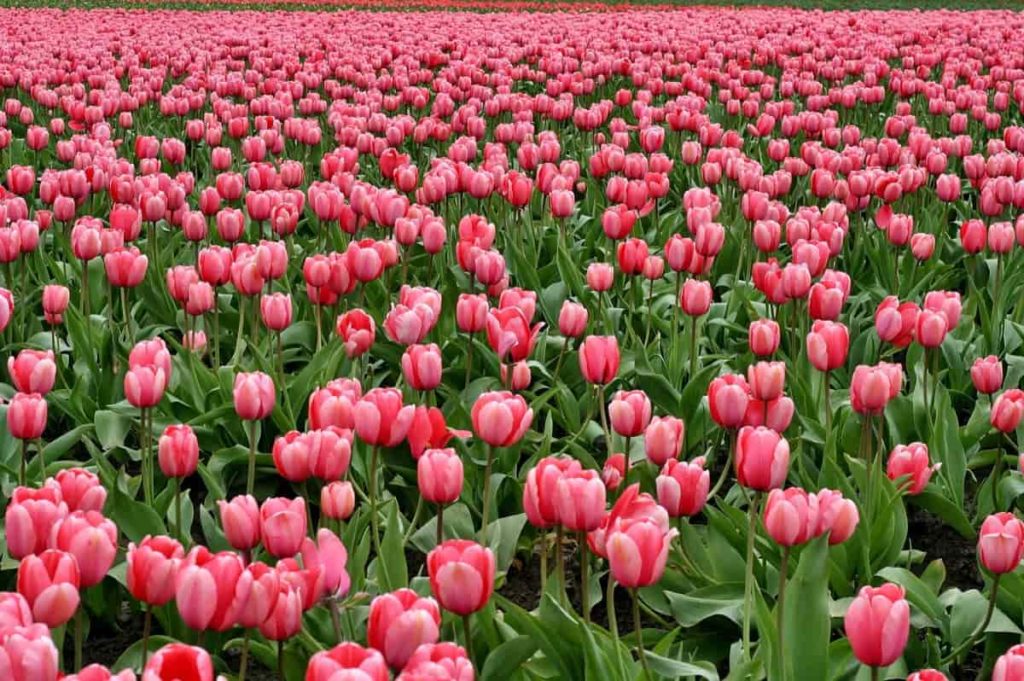
Purple Passion
Purple passion is a common wildflower in the United States and is used as herbal medicine. Medium maintenance but needs plenty of space as it is an aggressive spreading vine. Fertilize two or three times per year to maintain vigorous growth. Grows along the ground or will climb any supporting object in a sunny location such as fences, trellises, or arbors.
It often spreads beyond where you originally planted it, so give it room to roam. The Purple Passion flower is a fast-growing, evergreen, tendril-climbing vine. This sprawling plant is surprisingly hardy, and the striking, fragrant flowers attract butterflies and other pollinators. Native Americans cultivated this southeastern American native for its orange-yellow edible fruits and as a winter food source for wildlife.
If you want to encourage flower production rather than excessive plant growth, try to prevent spreading root growth. Growing this plant in a container works well in these cases. Purple passionflower is a highly flammable plant, so it would not be the best choice to grow in your home in areas prone to wildfires.
Conclusion
Exotic flowers and plants add a special touch to your garden or home with their unusual and beautiful shapes and colors. Growing exotic plants can be rewarding because of their vibrant flowers and unique shapes, but plants cannot thrive without hard work and constant care. Most exotic plants require constant attention to thrive, including maintaining the plants’ perfect environmental balance of temperature, light, and humidity.
- Types of Pesticides Used in Agriculture: A Beginner’s Guide
- Economical Aquaculture: A Guide to Low-Budget Fish Farming
- 15 Common Planting Errors That Can Doom Your Fruit Trees
- How to Make Houseplants Bushy: Effective Tips and Ideas
- Innovative Strategies for Boosting Coconut Pollination and Yield
- Pollination Strategies for Maximum Pumpkin Yield
- The Complete Guide to Chicken Fattening: Strategies for Maximum Growth
- Natural Solutions for Tulip Problems: 100% Effective Remedies for Leaf and Bulb-Related Issues
- Revolutionizing Citrus Preservation: Towards a Healthier, Greener Future
- Natural Solutions for Peony Leaf and Flower Problems: 100% Effective Remedies
- Maximizing Profits with Avocado Contract Farming in India: A Comprehensive Guide
- Natural Solutions for Hydrangea Problems: 100% Effective Remedies for Leaf and Flowers
- The Ultimate Guide to Choosing the Perfect Foliage Friend: Bringing Life Indoors
- From Sunlight to Sustainability: 15 Ways to Use Solar Technology in Agriculture
- The Ultimate Guide to Dong Tao Chicken: Exploring from History to Raising
- The Eco-Friendly Makeover: How to Convert Your Unused Swimming Pool into a Fish Pond
- Mastering the Art of Delaware Chicken Farming: Essentials for Healthy Backyard Flocks
- 20 Best Homemade Fertilizers for Money Plant: DIY Recipes and Application Methods
- How to Craft a Comprehensive Free-Range Chicken Farming Business Plan
- Brighten Your Flock: Raising Easter Egger Chickens for Beauty and Bounty
- How to Optimize Your Poultry Egg Farm Business Plan with These Strategies
- Subsidy for Spirulina Cultivation: How Indian Government Schemes Encouraging Spirulina Farmers
- Ultimate Guide to Raising Dominique Chickens: Breeding, Feeding, Egg-Production, and Care
- Mastering the Art of Raising Jersey Giant Chickens: Care, Feeding, and More
- Ultimate Guide to Raising Legbar Chickens: Breeding, Farming Practices, Diet, Egg-Production
- How to Raise Welsummer Chickens: A Comprehensive Guide for Beginners
- How to Protect Indoor Plants in Winter: A Comprehensive Guide
- Ultimate Guide to Grow Bag Gardening: Tips, Tricks, and Planting Ideas for Urban Gardeners
- Guide to Lotus Cultivation: How to Propagate, Plant, Grow, Care, Cost, and Profit
- Agriculture Drone Subsidy Scheme: Government Kisan Subsidy, License, and How to Apply Online
- Ultimate Guide to Raising Araucana Chickens: Breed Profile, Farming Economics, Diet, and Care
- Bringing Hydroponics to Classroom: Importance, Benefits of Learning for School Students
- Ultimate Guide to Raising Polish Chickens: Breed Profile, Farming Economics, Diet, and Care
- Ultimate Guide to Raising Australorp Chickens: Profile, Farming Economics, Egg Production, Diet, and Care
- Silkie Chicken Farming: Raising Practices, Varieties, Egg Production, Diet, and Care
- Sussex Chicken Farming: Raising Practices, Varieties, Egg Production, Diet and Care